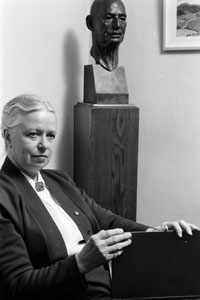Sylvia Daoust facts for kids
Quick facts for kids
Sylvia Daoust
|
|
|---|---|

Sylvia Daoust by Gabriel Desmarais
October 1963 Bibliothèque et Archives nationales du Québec |
|
| Born | May 24, 1902 Montreal, Quebec, Canada
|
| Died | June 19, 2004 (aged 102) Montreal, Quebec, Canada
|
| Resting place | Notre Dame des Neiges Cemetery |
| Education | Council of Arts & Manufactures, Ecole des Beaux-Arts, Montreal |
| Known for | Sculptor |
Sylvia Daoust (born May 24, 1902 – died July 19, 2004) was a famous Canadian artist. She was one of the first important female sculptors in Quebec. Sylvia studied art at the Council of Arts & Manufactures and the École des Beaux-Arts in Montreal. She also learned from well-known artists like Edwin Holgate.
Sylvia won many awards for her art. Her sculptures were shown in galleries in Canada, the United States, and Italy. She was especially known for making sculptures of people's faces, called portraits. She also helped bring new life to religious art. Sylvia Daoust was a founding member of a group called Le Retable d’Art Sacre. This group worked to improve religious art in Catholic churches in French Canada. She passed away in Montreal in 2004 when she was 102 years old.
Contents
Early Life and Art Education
Sylvia Daoust was born in Montreal, Quebec, on May 24, 1902. She was the oldest of seven children. From a very young age, Sylvia loved to draw, sketch, paint, and sculpt small clay figures.
Religious sisters noticed her talent for sculpting. They encouraged her to study art at the École des Beaux-Arts de Québec. In 1915, she began her art studies at the Conseil des arts et manufactures. Her teachers included Joseph Franchère and John Young Johnstone.
Studying at the École des Beaux-Arts
In 1923, Sylvia joined the École des Beaux-Arts, which had just opened. She worked hard and graduated in 1927 with a special teaching degree in drawing. In 1929, Sylvia won a big art competition called the Lord Willingdon Competition. She took first place in sculpture in this competition, which included artists from different provinces.
That same year, she received a scholarship from the province of Québec. This scholarship allowed her to travel and study art in France. While in France, she learned from another artist named Henri Charlier.
Teaching Art
Sylvia returned to Canada in 1930. She started teaching drawing, anatomy, modeling, and sculpting. She taught at the École des Beaux-Arts in Québec City until 1943.
After that, Sylvia moved back to Montreal. She became a professor at the Montreal School of Fine Arts. From 1943 to 1968, she taught students how to sculpt with wood and stone. Sylvia Daoust was buried in the Notre Dame des Neiges Cemetery in Montreal after she passed away.
Her Artistic Work
Most of Sylvia Daoust's art pieces are religious. Her sculptures often mixed modern art styles with the simple, strong look of medieval sculptures.
Even though she taught a lot, Sylvia also had a big career as an artist. In 1948, she started working more with modernist art. She worked alongside another artist, Paul-Émile Borduas.
Focus on Sacred Art
In the early 1940s, there was a movement to create more sacred (religious) art. During this time, Sylvia met Dom Paul Bellot, an architect. He designed the Saint Benedict Abbey in Saint-Benoit-du-Lac, Quebec.
Sylvia decided to focus on religious art. She worked with Dom Bellot at Saint Joseph's Oratory. She also worked with Henri Charlier, her former teacher from France. Sylvia made about thirty wooden statues during this time. She added colors and tried new materials like aluminum and leather.
Exhibitions and Organizations
Sylvia Daoust showed her art in over twenty exhibitions. However, many of her religious works were placed in churches and other buildings, not just art galleries.
She was one of the first members of Le Retable d’Art Sacre. This group worked to improve the quality of religious art in Catholic churches in Quebec. Sylvia continued to sculpt even into her 90s. Her last works were for a chapel in Montreal.
Important Artworks and Awards
You can find Sylvia Daoust's sculptures in major art collections. These include the Musée national des beaux-arts du Québec and the National Gallery of Canada.
Public Sculptures
Some of her public sculptures are:
- A bronze statue of Nicolas Viel on the outside of the Quebec Legislature.
- The statue of Mary Queen of the World at Montreal's Mary, Queen of the World Cathedral.
- A statue of Édouard Montpetit at the Université de Montréal.
Awards and Recognition
Sylvia Daoust received many awards for her artistic talent:
- In 1942, she won first prize for her work Our Lady of Montreal. This was part of a competition celebrating 300 years since the founding of St. Jean Baptiste.
- In 1951, she became a member of the Royal Canadian Academy of Art.
- In 1961, she received the Royal Architectural Institute of Canada's Allied Arts Award.
- In 1975, she won the Philippe Hébert Prize from the St. Jean Baptiste Society.
- In 1976, she was made a member of the Order of Canada. This is one of Canada's highest honors.
- In 1987, she was honored as a knight of the National Order of Quebec.
Honours
- Allied Arts Medal, Royal Architectural Institute of Canada, 1961.
- Royal Society of Canada
- Order of Canada, 1976
- National Order of Quebec
- Royal Canadian Academy of Arts
Images for kids



